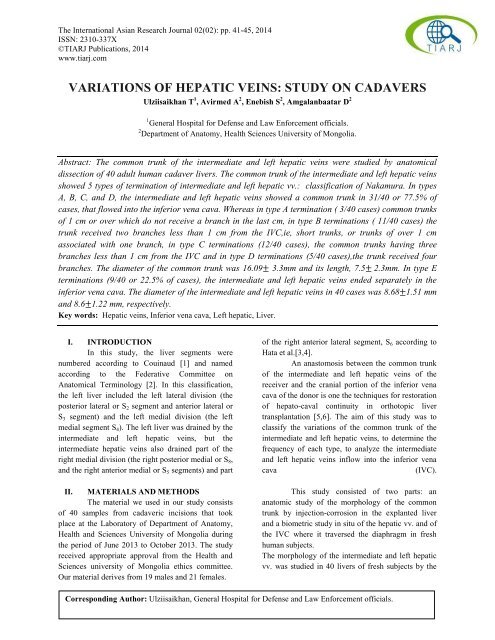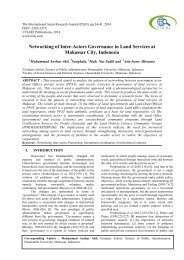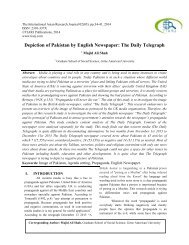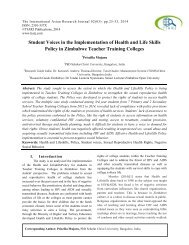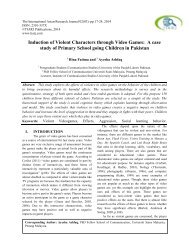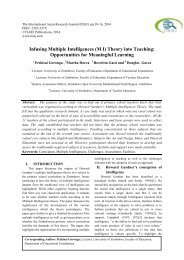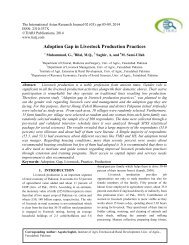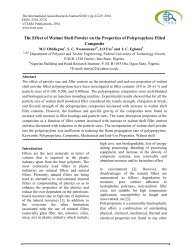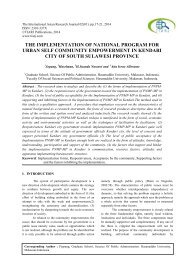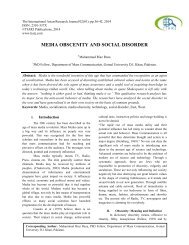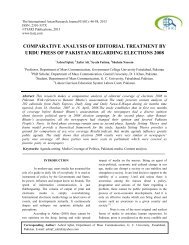VARIATIONS OF HEPATIC VEINS: STUDY ON CADAVERS
Create successful ePaper yourself
Turn your PDF publications into a flip-book with our unique Google optimized e-Paper software.
The International Asian Research Journal 02(02): pp. 41-45, 2014<br />
ISSN: 2310-337X<br />
©TIARJ Publications, 2014<br />
www.tiarj.com<br />
<strong>VARIATI<strong>ON</strong>S</strong> <strong>OF</strong> <strong>HEPATIC</strong> <strong>VEINS</strong>: <strong>STUDY</strong> <strong>ON</strong> <strong>CADAVERS</strong><br />
Ulziisaikhan T 1 , Avirmed A 2 , Enebish S 2 , Amgalanbaatar D 2<br />
1 General Hospital for Defense and Law Enforcement officials.<br />
2 Department of Anatomy, Health Sciences University of Mongolia.<br />
Abstract: The common trunk of the intermediate and left hepatic veins were studied by anatomical<br />
dissection of 40 adult human cadaver livers. The common trunk of the intermediate and left hepatic veins<br />
showed 5 types of termination of intermediate and left hepatic vv.: classification of Nakamura. In types<br />
A, B, C, and D, the intermediate and left hepatic veins showed a common trunk in 31/40 or 77.5% of<br />
cases, that flowed into the inferior vena cava. Whereas in type A termination ( 3/40 cases) common trunks<br />
of 1 cm or over which do not receive a branch in the last cm, in type B terminations ( 11/40 cases) the<br />
trunk received two branches less than 1 cm from the IVC,ie, short trunks, or trunks of over 1 cm<br />
associated with one branch, in type C terminations (12 /40 cases), the common trunks having three<br />
branches less than 1 cm from the IVC and in type D terminations (5/40 cases),the trunk received four<br />
branches. The diameter of the common trunk was 16.09± 3.3mm and its length, 7.5± 2.3mm. In type E<br />
terminations (9/40 or 22.5% of cases), the intermediate and left hepatic veins ended separately in the<br />
inferior vena cava. The diameter of the intermediate and left hepatic veins in 40 cases was 8.68±1.51 mm<br />
and 8.6±1.22 mm, respectively.<br />
Key words: Hepatic veins, Inferior vena cava, Left hepatic, Liver.<br />
I. INTRODUCTI<strong>ON</strong><br />
In this study, the liver segments were<br />
numbered according to Couinaud [1] and named<br />
according to the Federative Committee on<br />
Anatomical Terminology [2]. In this classification,<br />
the left liver included the left lateral division (the<br />
posterior lateral or S 2 segment and anterior lateral or<br />
S 3 segment) and the left medial division (the left<br />
medial segment S 4 ). The left liver was drained by the<br />
intermediate and left hepatic veins, but the<br />
intermediate hepatic veins also drained part of the<br />
right medial division (the right posterior medial or S 8 ,<br />
and the right anterior medial or S 5 segments) and part<br />
II. MATERIALS AND METHODS<br />
The material we used in our study consists<br />
of 40 samples from cadaveric incisions that took<br />
place at the Laboratory of Department of Anatomy,<br />
Health and Sciences University of Mongolia during<br />
the period of June 2013 to October 2013. The study<br />
received appropriate approval from the Health and<br />
Sciences university of Mongolia ethics committee.<br />
Our material derives from 19 males and 21 females.<br />
of the right anterior lateral segment, S 6 according to<br />
Hata et al.[3,4].<br />
An anastomosis between the common trunk<br />
of the intermediate and left hepatic veins of the<br />
receiver and the cranial portion of the inferior vena<br />
cava of the donor is one the techniques for restoration<br />
of hepato-caval continuity in orthotopic liver<br />
transplantation [5,6]. The aim of this study was to<br />
classify the variations of the common trunk of the<br />
intermediate and left hepatic veins, to determine the<br />
frequency of each type, to analyze the intermediate<br />
and left hepatic veins inflow into the inferior vena<br />
cava (IVC).<br />
This study consisted of two parts: an<br />
anatomic study of the morphology of the common<br />
trunk by injection-corrosion in the explanted liver<br />
and a biometric study in situ of the hepatic vv. and of<br />
the IVC where it traversed the diaphragm in fresh<br />
human subjects.<br />
The morphology of the intermediate and left hepatic<br />
vv. was studied in 40 livers of fresh subjects by the<br />
Corresponding Author: Ulziisaikhan, General Hospital for Defense and Law Enforcement officials.
The International Asian Research Journal 02 (02): 41-45, 2014<br />
technique of injection-corrosion. The corrosion cast<br />
methodology used has been<br />
reported on previously in detail (Ravnik et al. 1995).<br />
Acrylate monomers (acrylate powder and liquid,<br />
Polirepar S, Polident), used as prosthetic material in<br />
dentistry, were mixed and used for injection [7]. A<br />
polyurethane pigmentary paste of various colours<br />
was added to the mass, which was then injected into<br />
liver structures. The preparations, placed in a plastic<br />
mould of the upper part of the abdominal cavity,<br />
were put in a hot bath at +45ºC, where the injected<br />
mass completely polymerized in approximately 20-<br />
30min. After corrosion in hydrochloric acid, the cast<br />
of the vessels allowed study of the arrangement of the<br />
intermediate and left hepatic vv., measurement of the<br />
frequency of a common trunk and its length, noting<br />
the pattern of the collateral vv. The intermediate and<br />
left hepatic vv. weredistributed according to the<br />
classification of Nakamura [8]. The biometric of the<br />
hepatic vv. and the IVC was studied by measurement<br />
with a bougie calibrated on 40 livers in situ. The<br />
length of the common trunk was measured between<br />
the junction of the intermediate and left hepatic vv.<br />
and the ostium of this trunk in the IVC [5,9]. The<br />
diameter of the IVC was measured at its passage<br />
through the diaphragm.<br />
III. RESULTS<br />
A common trunk was present in 31 of the 40<br />
cases (77.5%). The result of the morphologic stu dy<br />
are given in Table 1 (Fig. 1A-E). In 9 cases (22.5%),<br />
the intermediate hepatic and left hepatic veins ended<br />
separately in the inferior vena cava. A type was in 3<br />
of the 40 cases (7.5%), B type in 11 (27.5%), C type<br />
in 12 (30%), D type in 5 (12.5), E type in 9 (22.5) .B,<br />
C types were present in the majority of all cases.<br />
The length of the common trunk varied from 5.5±2.1<br />
mm. The diameter of the new ostium created by<br />
section at 5 cm proximal to the junction of the<br />
intermediate and left hepatic vv. was 19.0±3.37 mm.<br />
That of the IVC at its diaphragmatic passage was<br />
23.6±2.72. However, the diameter of the actual<br />
ostium of the common trunk at its termination in the<br />
IVC was 16.09±3.32 mm.The result are given in<br />
Table 2.<br />
Opening patterns of intermediate and left<br />
hepatic veins, we observed 9/40 (22.5%) cases of<br />
single openings, followed by double openings 23/40<br />
(57.5%), triple openings 8/40 (20%).<br />
IV. DISCUSSI<strong>ON</strong><br />
The literature of the last years more and<br />
more indicates the importance of the hepatic veins in<br />
liver surgery, especially in living related liver<br />
transplantation [10]. This study was to classify the<br />
variations of the common trunk of the intermediate<br />
and left hepatic veins, to determine the frequency of<br />
each type, to analyze the intermediate and left hepatic<br />
veins inflow into the inferior vena cava (IVC).<br />
The diameter of the intermediate hepatic and left<br />
hepatic veins averaged 8.68±1.51mm, and<br />
8.33±1.22 mm, respectively. These values were<br />
similar to the 48.7±1.8 mm and 8.6±2.0 mm<br />
mentioned by Wind et al, but slightly smaller than the<br />
10.0±2.5 mm and 10.7±2.3 mm, respectively<br />
mentioned by Jose Roberto Ortale et al [6]. The<br />
frequency of 77.5% we observed for the confluence<br />
of the intermediate hepatic vein with the left vein to<br />
form a common trunk was within the range (50% -<br />
95%) reported by others [10,11].<br />
The length of this trunk was higher than 9.5<br />
mm in 10% of the cases of the IVC. This frequency<br />
was 9.4% in the cases reported by Wind et al, 10% in<br />
those reported by Jose Roberto Ortale et al, and 3.3%<br />
in those reported by Honda [6,12]. Several<br />
classifications based on the morphology of the<br />
common trunk have been described. Masselot and<br />
Leborgneproposed a simple classification into 3 types<br />
based solely on the length of the common trunk<br />
(common trunk short, long or absent) [10]. This<br />
classification is not sufficient to systematize all the<br />
varieties of common trunk that exits. Nakamura<br />
described a classification based on the branching of<br />
the intermediate and left hepatic vv. less than 1 cm<br />
from the IVC. Indeed, for this author 1 cm is the<br />
minimum length allowing control of the vein [5,8].<br />
Type A includes common trunks of 1 cm or more not<br />
receiving a branch in its last cm. Type B includes<br />
common trunks combined with two branches less<br />
than 1 cm from the IVC. Type C includes common<br />
trunk having three branches less than 1 cm from the<br />
IVC. Type D has four branches less than 1 cm away.<br />
Type E includes cases where there is no common<br />
trunk present.Of our 40 cases, 3 (7.5%) were type A,<br />
11 (27.5%) were B type, 12 (30%) were C type, 5<br />
(12.5%) were D type. The respective values reported<br />
by Wind et al. for 64 cases were: 6 (9.4%) were A, 25<br />
(39.06%) were B, 16 (25%) C, 7 (10.94%) were D.<br />
42
The International Asian Research Journal 02 (02): 41-45, 2014<br />
Thus, in type E, where the intermediate hepatic and<br />
left hepatic veins separately, were 9 (22.5%) in our<br />
cases, a frequency higher than the 15.6% and 15.66%<br />
mentioned by Wind et al. and Nakamura et al<br />
[5,8].According to the venous anatomy defined by<br />
Masselot et al [10] and Wind et al [5], we defined<br />
variations of the common trunk of the intermediate<br />
and left hepatic veins, to determine the frequency of<br />
each type, to analyze the intermediate and left hepatic<br />
veins inflow into the inferior vena cava (IVC). If<br />
resections along the intermediate and left hepatic vein<br />
(hemihepatectomy, liver lobe resection) are<br />
considered the segmental anatomy of the hepatic<br />
veins follows the Couinaud segmental anatomy.The<br />
venous segments/subsegments have to be considered<br />
independently in volume, position and shape of the<br />
corresponding Couinaud.<br />
V. C<strong>ON</strong>CLUSI<strong>ON</strong><br />
A common trunk for the intermediate and<br />
left hepatic vv. is present in 77.5% of cases. The<br />
intermediate hepatic and left hepatic veins ended<br />
separately in the inferior vena cava 22.5% in cases.<br />
B, C types were present in the majority of all cases.<br />
The increasing complexity of hepatic surgical<br />
procedures, necessitate widespread and appropriate<br />
knowledge of these anatomic variations, in order to<br />
avoid possible complications and help achieve the<br />
most effective result.<br />
Table 1. Classification of injection-corrosion 40<br />
specimens in term of the morphology of the<br />
intermediate and left hepatic vv.: comparison with<br />
the study of Wind in 64 livers<br />
E 9 (22.5) 10 (15.6) 13 (15.66)<br />
Table 2. Measurements made in 40 specimens<br />
having a common trunk<br />
Our studyWind et al Nakamura et al.<br />
Type No. of case (%)<br />
A 3 (7.5) 6 (9.4)9 (10.84)<br />
B 11 (27.5)25 (39.06)35 (42.17)<br />
C 12 (30) 16 (25) 22 (26.51)<br />
D 5 (12.5) 7 (10.94) 4 (4.82)<br />
Our studyWind et al.<br />
ParameterDiameter±SD (mm)<br />
Inferior vena cava23.3±2.7224.4±2.0<br />
Intermediate hepatic v. 8.68±1.518.7±1.8<br />
Left hepatic v.8.33±1.228.6±2.0<br />
Ostium of common trunk16.09±3.3213.6±1.9<br />
Table 3.Opening patterns of intermediate and left<br />
hepatic veins<br />
Combination patterns Number %<br />
Single opening 9 22.5<br />
Double opening 23 57.5<br />
Triple opening 8 20<br />
43
The International Asian Research Journal 02 (02): 41-45, 2014<br />
Fig 1 a-e<br />
a-e Casts of hepatic vv. obtained after injection-corrosion.<br />
Termination of intermediate and left hepatic vv. :<br />
classification of Nakamura. This classification is<br />
based on the branching of the intermediate and left<br />
hepatic vv. less than 1cm of the common trunk.<br />
When the common trunk measures less than 1cm, the<br />
intermediate and left hepatic vv. each count as one<br />
branch. Type A includes common trunks of 1 cm or<br />
more not receiving a branch in its last cm. Type B<br />
includes common trunks combined with two<br />
branches less than 1 cm from the IVC. Type C<br />
includes common trunk having three branches less<br />
than 1 cm from the IVC. Type D has four branches<br />
less than 1 cm away. Type E includes cases where<br />
there is no common trunk present<br />
REFERENCE<br />
1. Couinaud C. Posterior or dorsal liver. In:<br />
Couinaud C, ed. 1989.<br />
2. Surgical Anatomy of the liver Revisited.<br />
Paris: C Couinaud, pp. 123-134, 1998.<br />
3. Federative Committee on Anatomical<br />
Terminology. International Anatomical<br />
Terminology.Thieme: Stuttgart. 1998.<br />
4. Hata F, Hirata K, Murakami G, Mukaiya M.<br />
Identification of segments VI and VII of the<br />
liver based on ramification patterns of the<br />
intrahepatic portal and hepatic veins. Clin.<br />
Anat. 12: 229-244, 1999.<br />
5. Wind P, DouardR, Cugnenc P.H, Chevallier J.<br />
M. Anatomy of the common trunk of the<br />
middle and left hepatic veins: application to<br />
liver transplantation. SurgRadiolAnat21: 17-<br />
21,1999.<br />
6. Jose Roberto Ortale, Carolina Bonet, Patricia<br />
Fernanda Ferdiani Prado and Andrea Mariotto<br />
Braz. J. morphol. Sci. 20(1), 47-54, 2003.<br />
44
The International Asian Research Journal 02 (02): 41-45, 2014<br />
7. Ravnik D,Gadzijev EM, Solar<br />
M,Stanisavjevic. Modelle des<br />
oberenBauchraumes, der Lebergefaesse und<br />
der GallengaengealschirurgischeLehrmittel.<br />
Der Chirurg 66: 448-451, 1995.<br />
8. Nakamura S, Tsuzuki T. Surgical anatomy of<br />
the hepatic veins and the inferior vena cava.<br />
SurgGynecolObstet 152: 43-50, 1981.<br />
9. Lars Ole Schwen and Tobias Preusser (2012)<br />
Analysis and Algorithmic Generation of<br />
Hepatic Vascular Systems. International<br />
Journal Hepatology. 12: 15-17, 2012.<br />
10. Masselot R, Leborgne J. Etude anatomique<br />
des veinessushepatiques. AnatClin 1: 109-<br />
125, 1978<br />
11. Gupta SC, Gupta CD, Gupta<br />
SB.Hepatovenous segments in the human<br />
liver. J. Anat. 133, 1-6,1981.<br />
12. Honda H, Yanaga K,Kanero K, Murakami J,<br />
Masuda K. Ultrasonographic anatomy of<br />
veins draining the left lobe of the river.<br />
ActaRadiol 32, 479-484, 1991.<br />
13. Amir H. Foruzan, Yen-Wie Chen, Reza A.<br />
Zoroofi, Masaki Kaibori. Analysis of CT<br />
Images of Liver for Surgical Planning.<br />
American Journal of Biomedical Engineering.<br />
10: 23-28, 2012.<br />
45


